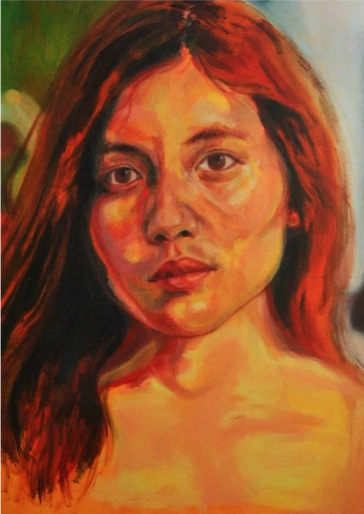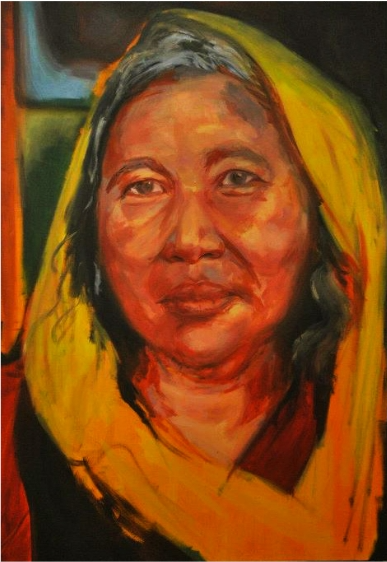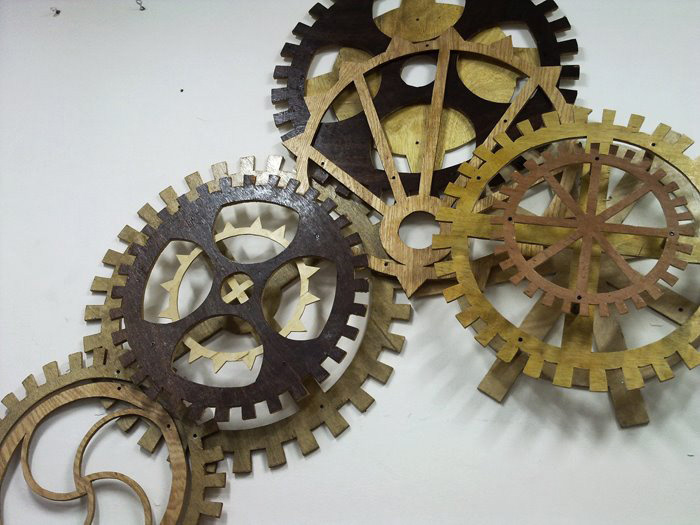
Young Lady, 2011, Oil on Canvas, 105cm x 90cm

Old Lady, 2011, Oil on Canvas, 105cm x 90cm

Clock Gears Sculpture, Changes in Time, 2011, Plywood and Mixed Media, 366cm x 214cm
Changes in Time
A portrait of a young lady and an older woman. The complex on both artwork shows multiples worlds within themselves, as we view a portrait of the painter painting herself in a self-portrait. Same lady pictured in two different times. Both paintings were painted using warm bright color and blurred background color. An intense face and an emotional expression on the young lady face. The older woman represents matured character and warm expression. Both eyes seems staring directly.
The artwork depicts a woman “Growing Old Gracefully”. Looking back through old photographs, we find that time contribute to changes in people, architecture and a lot of things. Most young people do not think about “growing old” which is understandable for they have yet to experience the reality of “growing old”; in the sense of declining in one’s physical strength and mental capabilities. For them getting older has always meant
getting better as they draw closer to the peak of their physical maturity. If they talk about “growing old”, it is often with disdain for the way many people spend their golden years. Discontented with life set in their ways bitter towards many people. This has prompted many young people to say: “I will never be like that when I get old!”. But growing old gracefully does not happen by accident. I have been blessed to know a number of such people in my life.
Yes, growing old gracefully is possible! When it occurs, it is beautiful to behold. When grace is joined with wrinkles, it is adorable. There is an unspeakable dawn in happy old age.
Change is the law of nature. Everything in nature changes and finally dies. There was a time when men was uncivilized and live like savages in forests. He did not know agriculture, but now he has conquered nature. He has become civilized. He has conquered the world in communication. Society also must change. It must constantly adapt itself to changing circumstances. When an individual or a society does not change, it stagnates and begins to rot.
The artwork depicts a woman “Growing Old Gracefully”. Looking back through old photographs, we find that time contribute to changes in people, architecture and a lot of things. Most young people do not think about “growing old” which is understandable for they have yet to experience the reality of “growing old”; in the sense of declining in one’s physical strength and mental capabilities. For them getting older has always meant
getting better as they draw closer to the peak of their physical maturity. If they talk about “growing old”, it is often with disdain for the way many people spend their golden years. Discontented with life set in their ways bitter towards many people. This has prompted many young people to say: “I will never be like that when I get old!”. But growing old gracefully does not happen by accident. I have been blessed to know a number of such people in my life.
Yes, growing old gracefully is possible! When it occurs, it is beautiful to behold. When grace is joined with wrinkles, it is adorable. There is an unspeakable dawn in happy old age.
Change is the law of nature. Everything in nature changes and finally dies. There was a time when men was uncivilized and live like savages in forests. He did not know agriculture, but now he has conquered nature. He has become civilized. He has conquered the world in communication. Society also must change. It must constantly adapt itself to changing circumstances. When an individual or a society does not change, it stagnates and begins to rot.
An individual must change according to his circumstances. He must adjust himself to the changed conditions of his life. If the circumstance of a rich man change and he becomes poor, he should change himself and work hard. Many of our customs and beliefs might have useful and desirable in the past, they must be changed the
conditions of life have changed.
conditions of life have changed.
When people changes over time, in the process they grow wrinkles. Wrinkles shows experience. The experience that people go through, be it bad experience or good experience, can be depicted in their wrinkles. If they have a frown line, then this mean that they have spent their younger days going through bad times. A laugh line means that the person is always smiling and laughing in their younger days.
Similarly when we look at changes in buildings, we see that what the building has gone through all through time. Buildings have their own beauty through time. For example Kelly’s Castle in Perak. The beauty of the castle until this days makes every visitor in awe because the love that the owner shows for his wife when building the castle. Kelly’s Castle and the Taj Mahal symbolizes love because of the beauty of the building.
Changes in the two buildings shows that it has undergone through hard times, the wear and tear of weather but still manage to project an image of beauty.
Changes in the two buildings shows that it has undergone through hard times, the wear and tear of weather but still manage to project an image of beauty.
Similarly the environment around us is changing all the time. The trees, the terrain, hills, mountains, rivers and the seaside changes through time and man is partly to blame for it. The beauty of Acheh was forever torn because of Tsunami. Looking back at old photographs of Aceh, it has certainly change through time. Changes happens and the beauty of the change remains in the memory and also the perspective of the beholder..